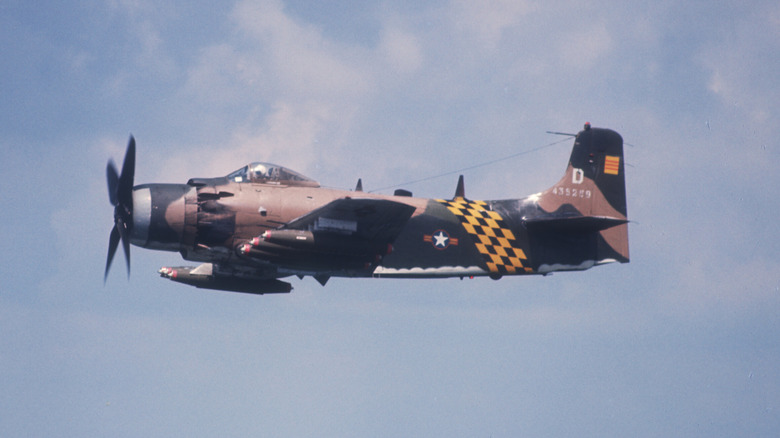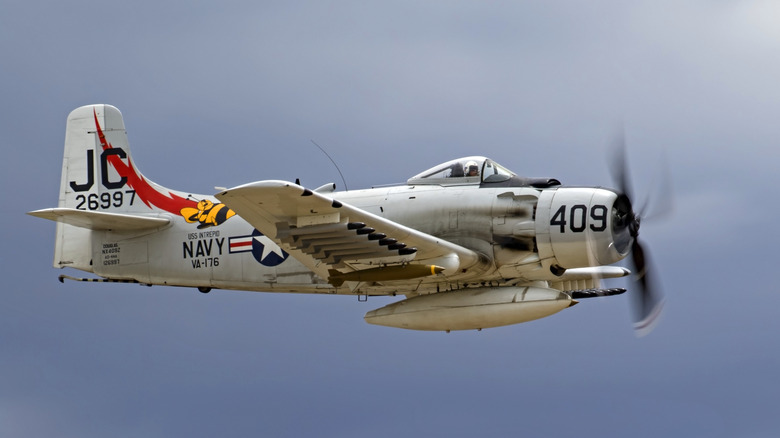One Of The US Military's Last Propeller-Driven Attack Aircraft Was A Star In Vietnam
When most people think of America's 20th-century attack aircraft, they likely picture something like the F-117A Nighthawk, the A-4 Skyhawk, or something similar. What people likely don't imagine is a propeller-driven aircraft. After all, the age of jets came about during the final years of World War II, and that conflict featured plenty of propeller-driven aircraft. Japan's A6M Zero, Germany's Messerschmitt Bf 109, and the U.S. P-51 Mustang are all well-known from this era, but what about after World War II?
Believe it or not, the U.S. didn't retire its propeller-driven attack aircraft and even built some new ones. The most notable of these was the A-1 Skyraider, first flown in 1945. The aircraft was developed during WWII as a carrier-based single-seat long-range attack aircraft. Initially, it was idealized as a dive and torpedo bomber, but the end of the war changed America's plans for the new aircraft. The A-1 was first introduced to the U.S. military in 1946, and throughout its production, a total of 3,180 were produced.
Just about every military service operated the A-1, including the U.S. Navy, Marine Corps, and Air Force. Outside the U.S., the aircraft was flown by the South Vietnam Air Force, French Air Force, and other nations. Over its service life, numerous variants were produced to meet specific needs, including upgraded engines, new radar technologies, sensors, and more. The A-1 was incredibly successful throughout its service history despite its lack of a jet engine, and it served the U.S. well in Vietnam.
Was the A1 Skyraider a good plane?
The A-1 Skyraider was a good plane, even compared to some jets. At the time of its introduction, jet engines were a relatively new technology, but the A-1 sported the tried and true propeller-driven engine that helped the Allies win during WWII. The A-1 was outfitted with a Wright R-3350-26WA Duplex-Cyclone, which was able to propel the aircraft through the sky at a maximum speed of 320 mph. Service ceilings fluctuate depending on which variant we're talking about, but the A-1 Skyraider was capable of at least a 28,500-foot ceiling, with some variants like the A-1E capable of reaching 32,000 feet.
In terms of armament, the A-1 boasted a variety of different systems, depending on the model. Initially, the A-1 featured four wing-mounted 20mm cannons as well as the capability to carry up to 8,000 lbs. of rockets, bombs, gun pods, and napalm canisters on its 15 hardpoints (this number could also differ based on which variant you're looking at). When the A-1 Skyraider entered the Vietnam War, the North Vietnamese Air Force (VPAF) was flying MiG-17s, MiG-21s, and other similar aircraft, all of which were jets. Despite this, the A-1 Skyraider gave them a run for their money.
The A-1 was ideal for close air support and combat search and rescue missions, as it could linger for longer due to the lower fuel requirements of its engine. Throughout the aircraft's time in Southeast Asia operations, A-1s flew over 90,000 combat sorties for the U.S. Air Force. It was an incredibly successful aircraft that saw heavy use throughout the conflict, showcasing its combat accuracy and overall survivability, though many were lost in action.
How many A1 skyraiders were lost in Vietnam?
The A-1 Skyraider was used heavily during the Vietnam War, and its success can be seen in the number of aircraft losses vs. how many sorties were flown. With more than 90,000 combat sorties flown, 266 A-1s were lost, 201 from the Air Force and 65 from the Navy. Those losses resulted in the deaths of 102 pilots from combat action. While that's certainly a lot of people, the number of aircraft losses indicates that only 0.3% of A-1 combat sorties resulted in the loss of an aircraft.
That's a figure few combat aircraft could match, so the A-1's success in Vietnam cannot be discounted. Still, more than 100 aviators lost their lives flying A-1s in Vietnam. A plaque honoring the men lost piloting A-1s in Southeast Asia has been on display at Hurlburt Air Park, Florida, since October 3, 1993. The aviator losses in Southeast Asia were from 1964 to 1972, covering America's involvement in the Vietnam War. While many lost their lives piloting the A-1, the aircraft performed well, earning numerous victories.
In the U.S. Air Force alone, two pilots earned the Medal of Honor, while 14 received Air Force Crosses for their service during the war. Many other pilots received awards for valor for their piloting of the A-1 during the conflict. A-1s that flew in Vietnam met and defeated MiG-17s, thanks to the A-1H's bank of cannons capable of firing 800 rounds per minute. Overall, despite losses in Southeast Asia, the A-1 was a highly successful attack aircraft, managing to survive against more powerful jets.


